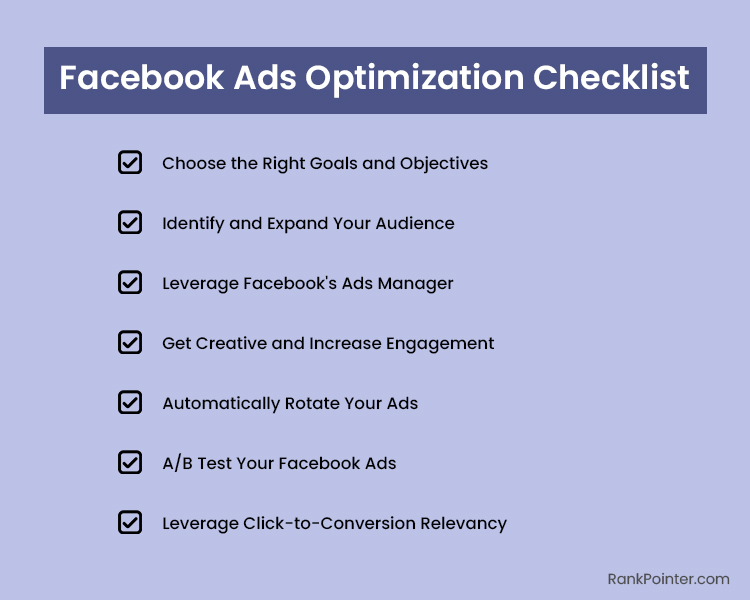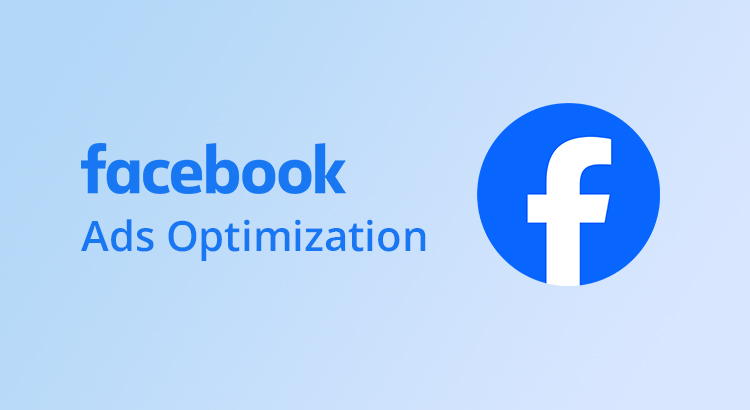Facebook campaign optimization is not a one-time task but rather an ongoing process that requires constant monitoring, analysis, and adjustment. By implementing deliberate and proven steps, advertisers can iterate their approach, improving the Return on Ad Spend (ROAS) and maximizing the impact of their campaigns.
Related Article: Facebook Ads Guide: Steps for Effective Campaigns
Facebook Ads Optimization Checklist
The steps for FB Ads optimization are listed below.
1. Choose the Right Goals and Objectives
Setting the foundation for a successful Facebook ad campaign begins with selecting the appropriate goals and objectives.
As you embark on this journey, Facebook prompts you to define your objectives, enabling its algorithms to optimize your campaign effectively. These objectives are categorized into three main groups: Awareness, Consideration, and Conversions.
It’s paramount to establish clear objectives from the outset. Start by identifying your advertising goals and what you aim to accomplish with the campaign.
Facebook offers an objectives chart that outlines various goals under each category, aiding in your decision-making process.
Learn More: Types of Facebook Ad Objectives: How to Choose the Right One
2. Identify and Expand Your Audience
Boosting Return on Ad Spend (ROAS) relies heavily on identifying your target audience and expanding your current base. Utilize Facebook Audience Insights to gather valuable data and eliminate guesswork.
This robust tool provides crucial insights into the demographics and preferences of your potential audience, enabling you to build personas and create content that resonates effectively.
Additionally, Facebook’s Audience Insights generates aggregated data about your current connections on the platform and identifies other users you should be targeting, facilitating audience expansion and optimization of your ad campaigns.
3. Leverage Facebook’s Ads Manager
Facebook’s Ads Manager serves as an indispensable hub for managing every aspect of your ad campaigns. From creating ads to tracking performance, it offers robust features for advertisers of all levels.
Upon opening Ads Manager, users can tailor campaigns, manage content, and utilize its intuitive tools for ad creation. Whether opting for quick creation or guided steps, Ads Manager simplifies the process.
Moreover, it enables users to duplicate ads, edit content, monitor metrics, analyze performance, and track ads across devices seamlessly.
- Duplicate ads quickly
- Edit ads efficiently
- Access comprehensive campaign metrics
- Analyze ad performance
- Monitor ads on any device
4. Get Creative and Increase Engagement
To ensure your ads resonate with your target audience, it’s essential to infuse them with creativity. Here are some strategies to consider:
- Utilize engaging media: Given Facebook’s visual nature, leverage eye-catching photos and graphics to capture attention.
- Create compelling copy: Engage users by incorporating storytelling, impressive statistics, and testimonials to highlight your offerings.
- Optimize CTAs: Select call-to-action buttons carefully to align with your messaging, ensuring consistency between ad content and CTA choices. Avoid discrepancies that may confuse users.
5. Automatically Rotate Your Ads
To combat ad fatigue and banner blindness, create multiple ad variations within an ad group and enable automatic rotation on Facebook.
This fosters healthy competition among ads, ensuring the most engaging ones receive prominence. Refresh ads when conversions decline and CPC rises to maintain effectiveness.
6. A/B Test Your Facebook Ads
A crucial aspect of Facebook ad optimization is identifying what resonates with your audience. A quick A/B test is the best approach to discover top-performing ad creatives, copy, and target audiences.
Facebook offers various methods to create A/B tests, depending on the variables you want to test. Utilize the Ads Manager Toolbar to initiate A/B tests, using existing ad campaigns as templates.
To analyze test results effectively, ensure your hypothesis is clear and measurable. Follow these steps:
- Navigate to the Ads Manager main table to access all available ads, campaigns, and ad sets.
- Select the campaigns or ad sets you wish to include in the A/B test by checking the corresponding boxes. Alternatively, choose “Custom” to duplicate a selected campaign or ad set and edit variables for the test.
- Click on the A/B Test option in the toolbar.
- Choose an available variable and proceed with the on-screen instructions to set up the test.
7. Leverage Click-to-Conversion Relevancy
While Facebook ad clicks are vital, they’re only one part of the equation. Maximizing success requires leveraging ad-to-page relevancy to maintain user engagement through the click-to-conversion journey.
This alignment between ad messaging and post-click destination not only meets user expectations but also builds brand trust.
Here are three key strategies to achieve click-to-conversion message consistency:
- Consistent Messaging: Ensure your ads and landing pages convey a unified message, highlighting your offer while keeping the content engaging.
- Unified Look and Feel: Maintain brand consistency in visuals and messaging throughout the user journey to enhance user experience and reduce bounce rates.
- Utilize Ad Targeting Data: Personalize ads based on targeting data to connect with each audience segment effectively, driving conversions and campaign success.
Learn more about conversion tracking.

Summary of FB Ads Optimization
Achieving success with Facebook ads is a complex approach which requires a combination of strategic planning, creative execution, and continuous refinement. By following the tips outlined in this article, advertisers can reach the full potential of their Facebook ad campaigns.


